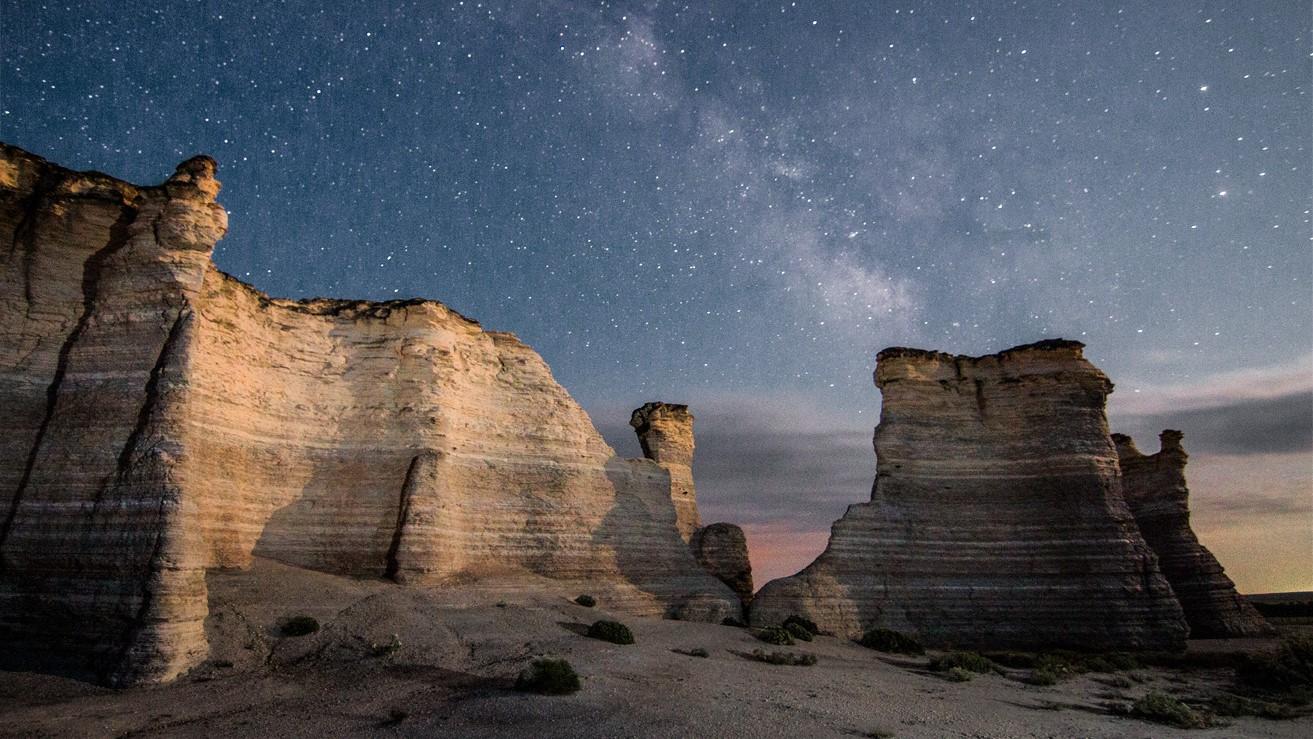Hunting sea monsters in Kansas is easier than you might think
Monument Rocks in western Kansas. The chalk formations are known for their rich fossil layers.
Hike long enough around the soft, chalky shales of western Kansas, and you just might stumble across a sea monster, half-buried in the soil.
That’s because 85 million years ago, Kansas was at the bottom of a gigantic, shallow sea that stretched from the Rockies all the way to the Appalachians, and from the Arctic Ocean to the Gulf of Mexico. Now, modern paleontologists are turning up riches in the sediments of that ancient seafloor.
The fossils paint a picture of a very different ocean ecosystem from what we would encounter today, says Laura Wilson, an associate professor of geosciences at Fort Hays State University and chief curator at the Sternberg Museum of Natural History.
“So you still have fish of all sizes — big teeth, those that are crushing shells — but there are no marine mammals,” she says. “So when we think of dolphins and whales and seals and sea lions, none of those had evolved yet, so those niches were filled by big marine reptiles” like mosasaurs, plesiosaurs and ichthyosaurs. “So big lizards, essentially, with big teeth and long tails that would be the top predators.”
“We also had some seabirds like we have today, but these [were] a lot more similar to their dinosaurian ancestors than the ones we might see flying around,” Wilson adds. “And then also we had the pterosaurs, so the big flying reptiles. They’re not birds, they’re not dinosaurs, but they were filling a lot of those aerial niches in the ecosystems.”
These strange animals don’t have direct descendants today, explains Mike Everhart, an adjunct curator of paleontology at the Sternberg Museum and the author of “Oceans of Kansas: A Natural History of the Western Interior Sea.”
“The marine lizards — the mosasaurs and so on — were related to modern snakes and monitor lizards, Komodo dragon-type stuff,” he says. “But they are not descendants. And of course, the pteranodons are all gone, most of the fish species. Of course, many lineages of fish are around today, but most of the ones that we collect or see out in the chalk went extinct about the same time as the dinosaurs.”
During the late Cretaceous period, marine animals had the benefit of a warm Earth that was about 85 percent covered in water, he says. “There were no ice caps, there were no glaciers, no real winter. So it was the marine animals that basically ran the Earth. The dinosaurs were all kind of limited to 15 percent of the mass.”
But today, hunting these sea monsters is a surprisingly leisurely undertaking in Kansas where, according to Everhart, the sea gave way to land at the end of the Cretaceous period, about 66 million years ago.
“Mike and I mostly — here in Kansas — spend our time in western Kansas, where when it comes to finding fossils, it’s finding the right age rock of the right environment at the surface of the Earth at the right time,” Wilson says.
“So right now in western Kansas [it’s] the chalks and the shales that have these fantastic creatures in them, and so we can go out, and it’s pretty low-tech. You walk around and look at the ground until you find something.”
Out in the badlands of western Kansas along the Smoky Hill, Saline, and Solomon rivers, “it’s just literally square miles of exposed chalk that you walk across," Everhart says. “And hopefully you find teeth, or you find a bone coming out, and that will lead you to a larger specimen, but it’s a lot of just walking and looking.”
If you do find a fossil, remember that it’s been in the ground for millions of years. “Once you start taking them out of the ground, they break down into pieces that are useless,” Everhart says. So if it’s big enough that you have to dig it up, he recommends calling a local museum. “Please contact someone who can help you do it right,” he says.
This article is based on an interview from Science Friday‘s recent live show at the Orpheum Theater in Wichita, Kansas.
